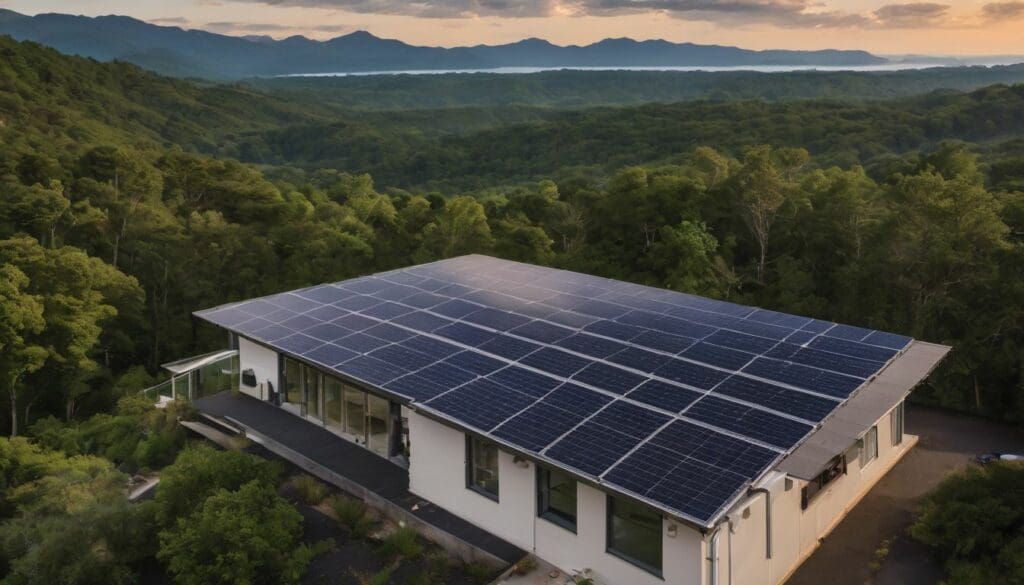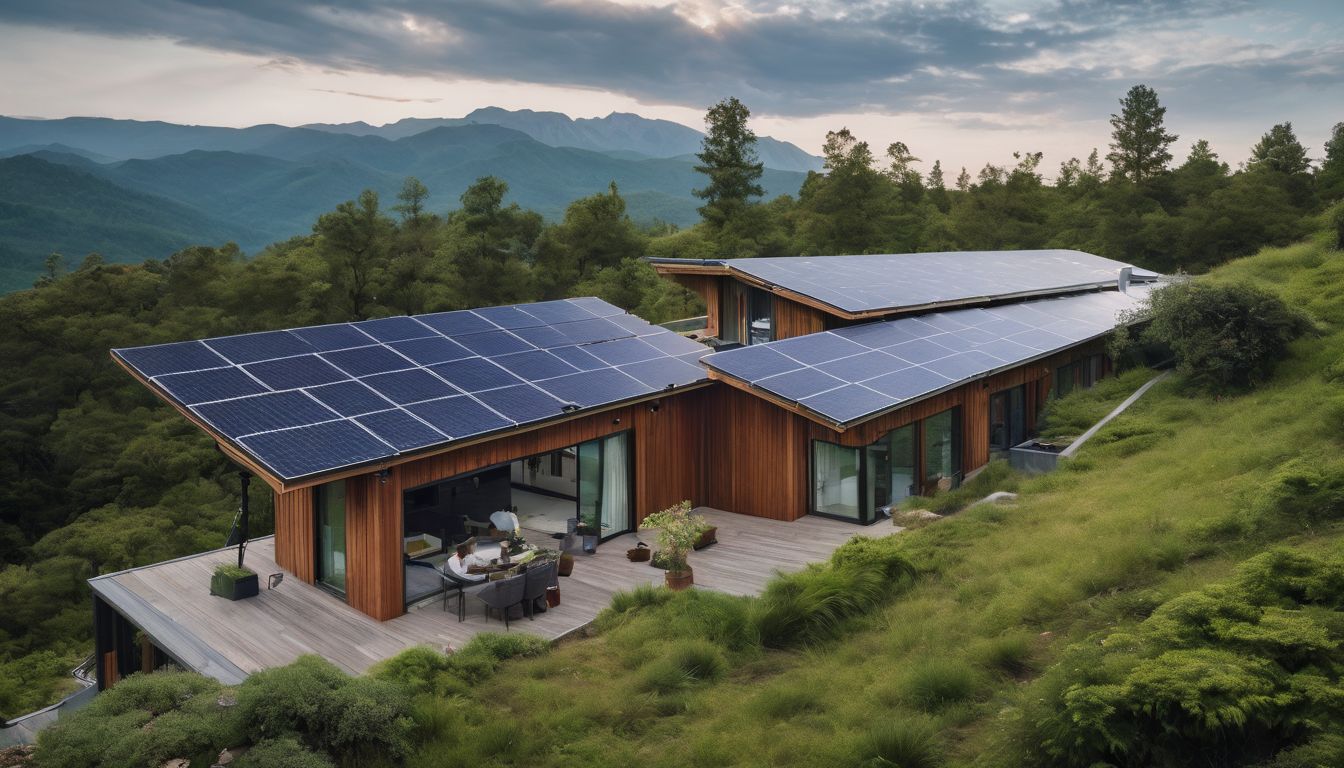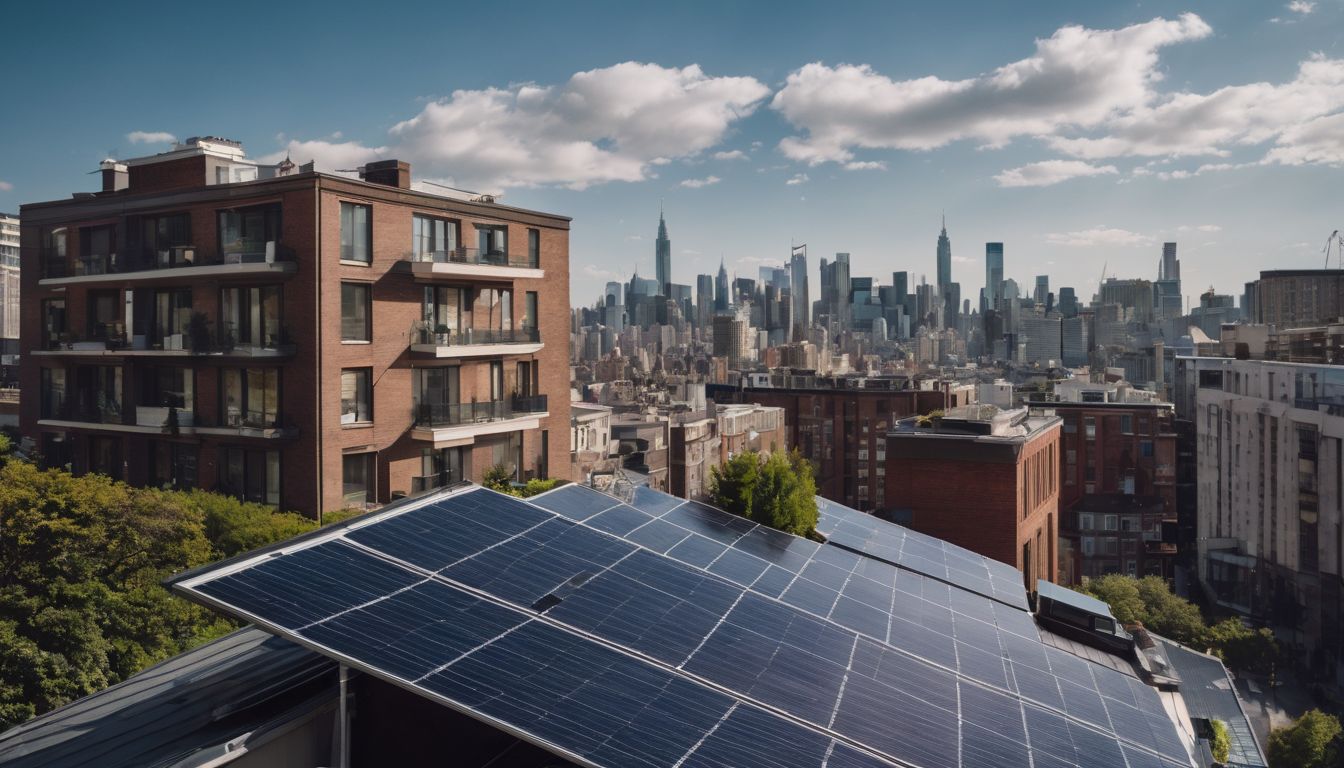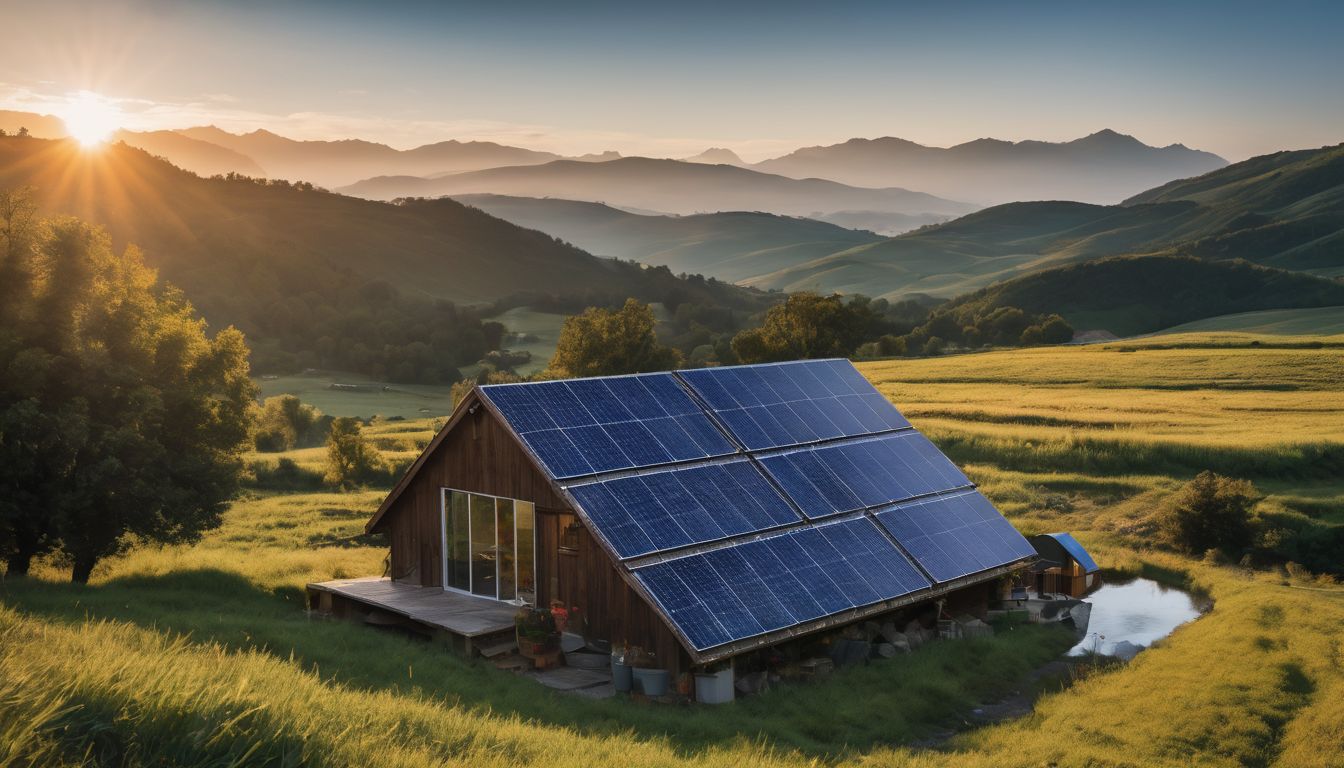Concerned about our planet’s future, many of us are keen to find sustainable energy solutions. In the UK, solar co-operatives have surged in popularity, harnessing the power of community for greener electricity.
This article delves into their growth and how they promise a brighter, renewable future for all. Discover why going solar together could be a game changer.
Key Takeaways
- Solar co – operatives are expanding rapidly across the UK, with a focus on community ownership and sustainable energy.
- Key factors driving their growth include advancements in solar technology, government incentives, and heightened public awareness of environmental issues.
- The regional distribution of solar farms across the UK varies, with some areas like South West England leading due to better sunlight exposure and availability of land.
- Large – scale solar farms such as Shotwick Solar Park and Cleve Hill Solar Park have significant capacities for renewable energy generation contributing to the national grid.
- While there is controversy around land use and wildlife impact, ongoing research aims to mitigate these effects through environmentally conscious siting and management.
The Current State of Solar Power in the UK
Solar power in the UK is growing, with solar farms becoming more prevalent across the country. Factors driving this growth include government support for renewable energy and advancements in solar technology.
Key trends include an increase in community-owned projects and a focus on achieving energy sustainability.
Regional Distribution of Solar Farms
The UK is witnessing a diverse regional spread of solar farms, harnessing the power of the sun across the land. Below is a table summarising the regional distribution:
| Region | Number of Solar Farms | Notable Solar Farms | Notes |
|---|---|---|---|
| South West England | High | Shotwick Solar Park | Region capitalises on high sunlight exposure |
| South East England | High | Cleve Hill Solar Park | Set to become one of the UK’s largest upon completion |
| East of England | Moderate | Wilburton Solar Farm | Known for its large-scale operations |
| West Midlands | Low to Moderate | Daniel Farm | Smaller scale farms, growing interest |
| North West England | Low | Carrington Solar Farm | Renewable energy gaining momentum |
| Wales | Moderate | Rheola | Investments increasing in the area |
| Scotland | Low | Errol Solar Farm | Challenging climate but potential for growth |
| Northern Ireland | Low | Ballyclare | Emerging market with room for expansion |
Advancements in technology are making less sunny regions viable for solar energy generation. Each area is adapting to the unique local climate and geographical advantages.
Factors Driving the Growth of Solar Farms
Several key factors are driving the remarkable growth of solar farms in the UK. The increasing demand for renewable energy sources is a major driver, as more communities and businesses seek to reduce their reliance on fossil fuels and lower their carbon footprint.
Additionally, advancements in technology have made solar power more efficient and cost-effective, further accelerating its adoption across the country. Policy support from the government and incentives such as feed-in tariffs have also played a crucial role in promoting the development of solar farms, making them an attractive investment for both private and community-owned projects.
Furthermore, growing public awareness about environmental sustainability has led to increased interest in supporting renewable energy initiatives like solar co-operatives. This heightened environmental consciousness among individuals and communities has significantly contributed to the expansion of solar farms, paving the way for a more sustainable future powered by clean energy alternatives.
Key Trends and Insights
Solar co-operatives are on the rise in the UK, with a growing number of community-owned projects contributing to renewable energy generation. The trend follows an increasing interest in green energy and cooperative initiatives, indicating a shift towards more sustainable electricity production.
As environmental consciousness continues to drive demand for clean energy, solar co-operatives play a vital role in shaping the country’s renewable generation landscape.
The growth of solar co-operatives reflects a broader movement towards community control over renewable energy resources. With an emphasis on local ownership and participation, these initiatives contribute to the diversification of the energy market while aligning with environmentally conscious individuals’ support for conservation and green energy solutions.
Solar Farms in the UK: Evolution and Controversy
Solar farms in the UK have evolved significantly over the years, from small-scale installations to large commercial projects. However, they have also been a source of controversy due to concerns about land use and their impact on wildlife.
Evolution of Solar Farms in the UK
Solar farms in the UK have evolved significantly over the past decade, with technological advancements and increasing environmental awareness driving their growth. They have transitioned from being small-scale community projects to large commercial ventures, contributing significantly to renewable energy targets.
The development of solar farms has been supported by government policies and incentives aimed at promoting sustainable energy sources, fostering a shift away from traditional power generation methods.
Looking forward, the evolution of solar farms is likely to continue as technology improves further and community-owned projects become more prevalent. With an increased focus on sustainability and reduced carbon emissions, solar farms are set to play an even more significant role in the UK’s energy landscape.
Controversy Surrounding Solar Farms
After the evolution of solar farms in the UK, it’s important to address the controversy surrounding these energy-producing facilities. Solar farms have faced criticism for their impact on land use and potential effects on wildlife.
Concerns have been raised about the use of agricultural land for solar installations, as well as their visual impact on rural landscapes. The construction of large-scale solar farms has also sparked debates about their potential disruption to local ecosystems and habitats.
Opponents argue that despite being a source of renewable energy, solar farms can still negatively impact biodiversity and natural ecosystems. The controversy surrounding solar farms highlights the need for careful consideration of location and environmental assessments to minimise adverse effects.
Regional Analysis of Solar Farms in the UK
The regional breakdown of solar farms in the UK highlights the diversity of solar power generation across different parts of the country. From the top 10 biggest solar farms to the overall distribution, each region contributes to the growing impact of solar energy in the UK.
Regional Breakdown of Solar Farms
Solar farms in the UK are distributed across different regions, with significant clusters in areas such as the South West and the South East. These regions benefit from ample sunlight and available land, making them ideal for solar power generation. Additionally, Scotland is emerging as a promising region due to its commitment to renewable energy initiatives. The Midlands and Wales have also seen growing interest in solar farms, contributing to the overall expansion of clean energy sources.
The placement of solar farms emphasises maximising sun exposure and proximity to electrical infrastructure for efficient power distribution. As a result, these regional differences offer unique opportunities for sustainable energy production while considering local environmental impact and community involvement.
Top 10 Biggest Solar Farms in the UK
The top 10 biggest solar farms in the UK are significant contributors to the country’s renewable energy landscape. They showcase the potential and impact of solar power across different regions.
- Shotwick Solar Park in Flintshire, Wales: With a capacity of 72.2 MW, it powers over 18,000 homes.
- Parley Solar Farm in Dorset, England: Generating 76 MW, it reduces carbon emissions by 31,600 tonnes annually.
- Wymeswold Solar Farm in Leicestershire, England: Capacity of 69.8 MW provides clean energy for approximately 19,500 households.
- Bannerton Solar Farm in Nottinghamshire, England: The farm has a capacity of 81 MW and is a significant contributor to local renewable energy production.
- Goodenough Solar Farm in Devon, England: It generates 49.9 MW and plays a vital role in meeting the region’s sustainable energy targets.
- Cleve Hill Solar Park in Kent, England: As one of the largest solar projects with a capacity of 350 MW, it underscores the potential for large-scale solar generation.
- South Field Energy Center in Leicestershire, England: Producing 62 MW of renewable electricity contributes significantly to the region’s clean energy goals.
- Bradenstoke Solar Park in Wiltshire, England: At a capacity of 55 MW, it assists in reducing reliance on fossil fuels and cutting carbon emissions.
- Elmswell Solar Farm in Suffolk, England: The farm produces approximately 68 MW and supports regional efforts towards sustainability and clean energy usage.
- Lyneham Solar Park in Gloucestershire, England: With a capacity of 66 MW, it makes a substantial contribution to the local green energy supply.
Solar Power Generation by Region
Moving from the discussion of the top 10 biggest solar farms in the UK, it is interesting to note the regional distribution of solar power generation. Across the various regions of the UK, solar energy generation plays a significant role in contributing to renewable energy targets. In particular, southern regions such as Cornwall and Devon boast high levels of solar power production due to their favorable climate conditions and available land for solar panel installation.
In addition, other regions like East Anglia and Yorkshire have also seen considerable growth in solar power generation, with both residential and commercial installations boosting overall capacity. The commitment to sustainability by communities across these areas has led to an increase in community-owned projects supported by cooperative renewable energy initiatives that are driving positive change for environmental conservation efforts at a regional level.
Pros and Cons of Solar Farms
Solar farms offer an improved use of renewable energy and community control, but controversy surrounds land use and its effects on wildlife.
To learn more about the growth of solar co-operatives in the UK, keep reading!
Pros: Improved Renewable Energy Usage and Community Control
Solar co-operatives contribute to the increased use of renewable energy sources in the UK. They enable local communities to have a say in energy production and usage. This empowers individuals with collective control over their energy resources.
- Enhanced Community Involvement: Solar co-operatives allow community members to invest in, own, and benefit from renewable energy projects, fostering a sense of participation and ownership.
- Local Economic Development: By promoting the development of solar farms at a local level, co-operatives contribute to economic growth by creating job opportunities and stimulating business activities within the community.
- Environmental Benefits: Solar co-operatives promote the reduction of greenhouse gas emissions, thus contributing to a cleaner environment and mitigating climate change effects.
- Energy Security: By diversifying energy sources, solar co-operatives enhance the stability of the local energy supply, reducing reliance on external factors for energy needs.
- Social Impact: Community-owned solar projects often allocate part of their profits towards community initiatives such as education programs or supporting vulnerable groups, enhancing social welfare.
Cons: Controversy Surrounding Land Use and Effects on Wildlife
The expansion of solar farms has sparked debates due to concerns about land use and effects on wildlife. These controversies have raised valid points about the impacts of solar farms on the environment, including:
- Land Use: Solar farms may require large areas of land, potentially leading to habitat loss for wildlife and disruption of natural ecosystems.
- Wildlife Impact: The installation and operation of solar farms can disturb local wildlife, affecting their habitats and migration patterns.
- Visual Impact: Some people find the presence of large solar panels unsightly, impacting the scenic beauty of rural landscapes.
- Maintenance Disruption: The construction and maintenance activities associated with solar farms can lead to disturbances that affect local flora and fauna.
- Reclaimed Land Concerns: There are concerns about reclaiming agricultural or natural land for solar farm development, raising issues related to food production and biodiversity.
Growth and Future of Solar Co-operatives in the UK
Solar co-operatives are on the rise in the UK, offering community-owned projects and a sustainable way to generate renewable energy. To learn more about the growth and future prospects of solar co-operatives in the UK, read our full blog post!
Growth of Solar Co-operatives
Solar cooperatives are rapidly expanding across the UK, reflecting a growing trend towards community-owned renewable energy projects. These cooperative ventures empower local communities to take an active role in promoting sustainable energy practices, spurring economic growth and reducing reliance on non-renewable resources.
With increasing support for environmental conservation and clean energy initiatives, solar cooperatives are playing a pivotal role in shaping the future of the country’s renewable energy market.
As solar power becomes more accessible and cost-effective, its potential to transform local communities is increasingly recognised. Through collaborative efforts, solar cooperatives contribute significantly to advancing environmental sustainability and fostering a sense of shared responsibility among individuals passionate about conservation.
Prospects for Solar Co-operatives
With the growth of solar co-operatives in the UK, there are promising prospects for expanding community-owned projects and renewable energy initiatives. Individuals who champion conservation and environmental causes have an opportunity to actively participate in supporting wind power and community energy through these cooperative ventures.
Renewable energy coops present a significant step towards fostering environmentally conscious communities, where people can collectively contribute to sustainable energy generation while having a direct stake in the development and maintenance of such projects.
The Role of Solar Co-operatives in the UK’s Renewable Energy Market
Solar co-operatives play a crucial role in the UK’s renewable energy market by empowering local communities to take control of their energy production. These community-owned projects enable environmentally conscious individuals to invest in and benefit from solar power generation, which contributes significantly to reducing the country’s carbon footprint.
By participating in energy cooperatives, individuals can support conservation efforts and promote sustainable living while having a direct impact on the region’s environmental health.
In addition to promoting renewable energy usage, solar co-operatives foster a sense of community ownership and responsibility towards sustainable development. Through these initiatives, local residents can actively engage in shaping the future of their energy resources and influence positive environmental change.
Conclusion
In conclusion, solar co-operatives are on the rise in the UK, offering communities greater control over their energy sources. The growth of these community-owned projects is providing environmentally conscious individuals with an opportunity to actively support conservation efforts.
As we look to the future, these co-operatives will play a vital role in advancing the UK’s renewable energy market and promoting sustainable practices for generations to come.
FAQs
1. What are solar co-operatives in the UK?
Solar co-operatives in the UK are community-owned projects where groups of people join together to produce renewable energy from solar panels.
2. Why are solar co-operatives growing in popularity?
The growth is due to increased interest in green energy and the desire for communities to take control of their local power generation, reducing reliance on traditional energy sources.
3. Can anyone start a community-owned solar project?
Yes, any group of individuals can come together to start a community-owned solar project with proper planning and resources.
4. What benefits do these community projects bring?
These projects provide cleaner energy, help save on electricity bills for members, and strengthen community bonds by working towards a common sustainable goal.





